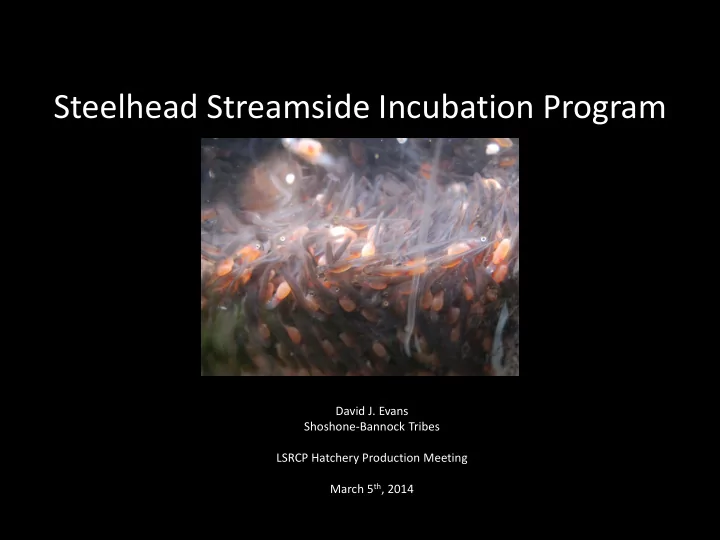

Steelhead Streamside Incubation Program David J. Evans Shoshone-Bannock Tribes LSRCP Hatchery Production Meeting March 5 th , 2014
Program Overview • Vision, Goals, and Objectives • Transition to B stock • Accomplishments • Future Work
Vision “The Tribes will pursue, promote, • and where necessary, initiate efforts to restore the Snake River systems and affected unoccupied lands to a natural condition. This includes the restoration of component resources to conditions which most closely represents the ecological features associated with a natural riverine ecosystem. In addition, the Tribes will work to ensure the protection, preservation, and where appropriate‐the enhancement of Rights reserved by the Tribes under the Fort Bridger Treaty of 1868 and any inherent aboriginal rights.”
Goals • Increase harvest opportunities for Tribal members • Provide connection with and protection of cultural and social values and rights • Develop an experimental project for assessing the potential for using artificial production to increase early life survival of steelhead and salmon populations
Management Objectives Harvest objectives • – increase from baseline conditions – preserve traditional fishing techniques Production objectives • – increase egg to fry survival test streamside incubation technology • determine optimum egg loading density and configurations • – incubate 1,000,000 eyed eggs annually Yankee Fork – 500,000 • Panther Creek – 400,000 • Indian Creek – 100,000 • Additional objectives • – minimize cost, process, and fish handling – increase community education, involvement, and participation – fulfill the requirements of US vs. Oregon
Program Features • remote incubation site set-up • acquisition of eyed-egg from local hatcheries • transportation of eyed-eggs to remote incubators • daily incubator operations and maintenance • dead egg count and volitionally fry release • remote incubation site disassemble
Program Accomplishments • Successfully hatching eggs each year (74 % in 99’ to over 95%) • Involved the community – Private Landowners • Secured funding to fully implement the program and conduct M&E • Integrating tribal staff into the scientific aspect of this tool
Monitoring, Research, & Evaluation • PIT tag array, rotary screw trap, and electrofishing – Consistency in what and when we monitor – Fully trained staff with a knowledge of the importance of consistency – Prepared to accommodate any of a variety of scenarios during the acquisition of eggs – The Yankee Fork wier in 2015
Future Work • Continue processing genetics and scales through IDF&G and ISU • Establish lead technicians that can stand alone on this project • Implement a study design that takes full advantage of the amazing research opportunity the new weir will provide
Questions
Recommend
More recommend